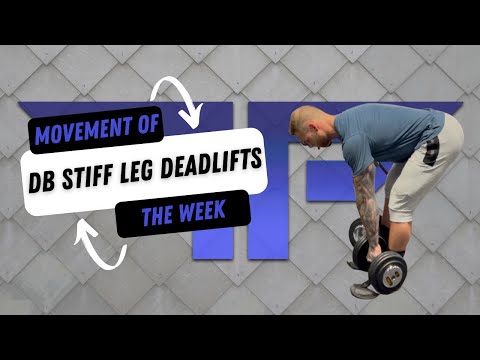Execution Cues:
-Make sure to pick the DBs up from an elevated surface. You can do the same with a barbell if you're wanting to start with the eccentric.
-Wear straps so your grip is not the limiting factor.
-Start with your abs braced, pelvis neutral and tension in your lats.
-Keep the DBs close to your legs throughout the rep in order to take pressure off your low back.
-Aim for the maximum stretch that you can get in your hamstrings without having to "reach" or round your back. (Quick note: Slight flexion/rounding is normal and ok especially through your thoracic spine. We want to prevent any changes in spinal positioning due to excessive load, weakness, or mobility limitations.)
-Tension will follow angles here so pay attention to the angle of your shins. They should be vertical or negative (angled away from the load) so the hamstrings remain the primary drivers.
Contraindications:
-Poor flexibility in hamstrings
-Poor mobility in hips
-Poor mobility in lumbar or thoracic spine
-Weak mid-back, lats, erectors, glutes and/or abdominal stabilizers
-Low back pain (anything that is worsened by hip flexion/extension or load bearing)
-Proximity to a competition or event (potential for soreness and/or reduced performance)
Regressions:
-DB RDLs (For those with flexibility or mobility limitations)
-KB Stiff Leg Deadlifts (For those struggling to keep the load tight to midline)
- 45º Hyperextensions (For those who have weakness through the mid-back and lats or mobility issues)
-Cable Pull-Throughs (For those who struggle with hip hinging)
Progressions:
-Barbell Stiff Leg Deadlifts (From Rack)
-Barbell Stiff Leg Deadlifts (From Floor)
-Deficit Barbell Stiff Leg Deadlifts
-Trap Bar Stiff Leg Deadlifts
-Hovering Barbell Stiff Leg Deadlifts
Volume Parameters:
-4-6 sets per week (Specific to the DB variation and NOT generalized to all Stiff Leg/Hinge patterns)
-8-15 rep range (Specific to the DB variation and NOT generalized to all Stiff Leg/Hinge patterns)
Applicable Intensity Techniques:
-Supersetting with a leg curl variation (My personal go-to is Seated Leg Curls into DB Stiff Leg Deadlifts)
-Cluster Sets
Programming Considerations:
DB Stiff Leg Deadlifts should be thought of as an accessory movement and not a primary hinge pattern for most. This is due to the inherent loading limitations that come with working with DBs that aren't present with barbells or other, more stable, modalities.
I like to program them as a complementary exercise to another overloading hinge or with a heavy squat, leg press or horizontal hip extension. They tend to be more effective when placed after other movements that get a lot of blood into the hamstrings so that the DB SLDL can then safely apply a stretch under load.
As with all hinges, intensity needs to be controlled and specified. This is a slightly risky variation for those who are not proficient so my general recommendation is to leave between 2-4 reps on most working sets. Additionally, volume must be tightly regulated due to the increased muscle damage that accompanies lengthening under load.
From a recovery and neural perspective, the increased ROM and unique limitations that come with DB SLDLs mean that local fatigue will accumulate quicker than systemic fatigue. This essentially means the muscle damage and soreness in the hamstrings will be what you have to pay attention to rather than there being too much "spill-over" of recovery decrements affecting other movements or subsequent sessions.
Primary Use Case:
Hypertrophy of Hamstrings

